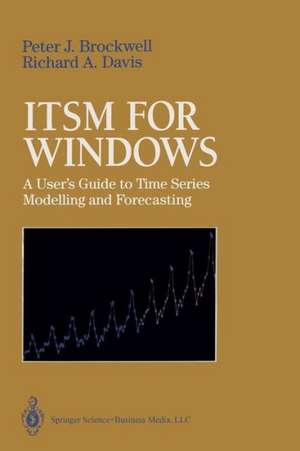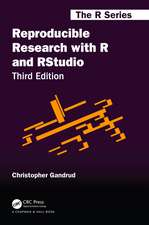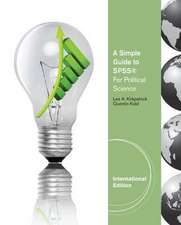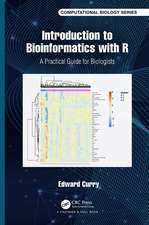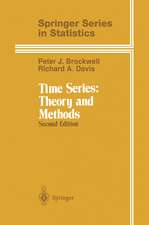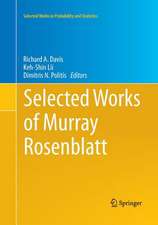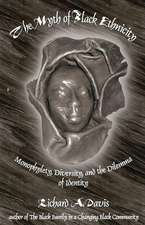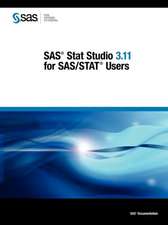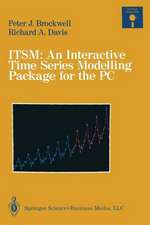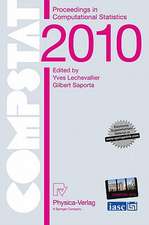ITSM for Windows: A User’s Guide to Time Series Modelling and Forecasting
Autor Peter J. Brockwell R.J. Hyndman Autor Richard a. Davisen Limba Engleză Paperback – 11 aug 1994
Preț: 326.13 lei
Preț vechi: 407.66 lei
-20% Nou
Puncte Express: 489
Preț estimativ în valută:
62.42€ • 64.92$ • 52.31£
62.42€ • 64.92$ • 52.31£
Carte tipărită la comandă
Livrare economică 13-27 martie
Preluare comenzi: 021 569.72.76
Specificații
ISBN-13: 9780387943374
ISBN-10: 0387943374
Pagini: 118
Ilustrații: IX, 118 p. 50 illus. With online files/update.
Dimensiuni: 155 x 235 x 14 mm
Greutate: 0.25 kg
Ediția:1994
Editura: Springer
Colecția Springer
Locul publicării:New York, NY, United States
ISBN-10: 0387943374
Pagini: 118
Ilustrații: IX, 118 p. 50 illus. With online files/update.
Dimensiuni: 155 x 235 x 14 mm
Greutate: 0.25 kg
Ediția:1994
Editura: Springer
Colecția Springer
Locul publicării:New York, NY, United States
Public țintă
Professional/practitionerDescriere
The analysis of time series data is an important aspect of data analysis across a wide range of disciplines, including statistics, mathematics, business, engineering, and the natural and social sciences. This package provides both an introduction to time series analysis and an easy-to-use version of a well-known time series computing package called Interactive Time Series Modelling. The programs in the package are intended as a supplement to the text Time Series: Theory and Methods, 2nd edition, also by Peter J. Brockwell and Richard A. Davis. Many researchers and professionals will appreciate this straightforward approach enabling them to run desk-top analyses of their time series data. Amongst the many facilities available are tools for: ARIMA modelling, smoothing, spectral estimation, multivariate autoregressive modelling, transfer-function modelling, forecasting, and long-memory modelling. This version is designed to run under Microsoft Windows 3.1 or later. It comes with two diskettes: one suitable for less powerful machines (IBM PC 286 or later with 540K available RAM and 1.1 MB of hard disk space) and one for more powerful machines (IBM PC 386 or later with 8MB of RAM and 2.6 MB of hard disk space available).
Cuprins
1 Introduction.- 1.1 The Programs.- 1.2 System Requirements.- 1.2.1 Installation.- 1.2.2 Running ITSM.- 1.2.3 Printing Graphs.- 1.3 Creating Data Files.- 2 PEST.- 2.1 Getting Started.- 2.1.1 Running PEST.- 2.1.2 PEST Tutorial.- 2.2 Preparing Your Data for Modelling.- 2.2.1 Entering Data.- 2.2.2 Filing Data.- 2.2.3 Plotting Data.- 2.2.4 Transforming Data.- 2.3 Finding a Model for Your Data.- 2.3.1 The ACF and PACF.- 2.3.2 Entering a Model.- 2.3.3 Preliminary Parameter Estimation.- 2.3.4 The AICC Statistic.- 2.3.5 Changing Your Model.- 2.3.6 Parameter Estimation; the Gaussian Likelihood.- 2.3.7 Optimization Results.- 2.4 Testing Your Model.- 2.4.1 Plotting the Residuals.- 2.4.2 ACF/PACF of the Residuals.- 2.4.3 Testing for Randomness of the Residuals.- 2.5 Prediction.- 2.5.1 Forecast Criteria.- 2.5.2 Forecast Results.- 2.5.3 Inverting Transformations.- 2.6 Model Properties.- 2.6.1 ARMA Models.- 2.6.2 Model ACF, PACF.- 2.6.3 Model Representations.- 2.6.4 Generating Realizations of a Random Series.- 2.6.5 Model Spectral Density.- 2.7 Nonparametric Spectral Estimation.- 2.7.1 Plotting the Periodogram.- 2.7.2 Plotting the Cumulative Periodogram.- 2.7.3 Fisher’s Test.- 2.7.4 Smoothing to Estimate the Spectral Density.- 3 SMOOTH.- 3.1 Introduction.- 3.2 Moving Average Smoothing.- 3.3 Exponential Smoothing.- 3.4 Removing High Frequency Components.- 4 SPEC.- 4.1 Introduction.- 4.2 Bivariate Spectral Analysis.- 4.2.1 Estimating the Spectral Density of Each Series.- 4.2.2 Estimating the Absolute Coherency Spectrum.- 4.2.3 Estimating the Phase Spectrum.- 5 TRANS.- 5.1 Introduction.- 5.2 Computing Cross Correlations.- 5.3 An Overview of Transfer Function Modelling.- 5.4 Fitting a Preliminary Transfer Function Model.- 5.5 Calculating Residuals from a Transfer Function Model.- 5.6 LS Estimation and Prediction with Transfer Function Models.- 6 ARVEC.- 6.1 Introduction.- 6.1.1 Multivariate Autoregression.- 6.2 Model Selection with the AICC Criterion.- 6.3 Forecasting with the Fitted Model.- 7 BURG.- 7.1 Introduction.- 8 ARAR.- 8.1 Introduction.- 8.1.1 Memory Shortening.- 8.1.2 Fitting a Subset Autoregression.- 8.2 Running the Program.- 9 LONGMEM.- 9.1 Introduction.- 9.2 Parameter Estimation.- 9.3 Prediction.- 9.4 Simulation.- 9.5 Plotting the Model and Sample ACVF.- Appendix A: The Screen Editor WORD6.- A.1 Basic Editing.- A.2 Alternate Keys.- A.3 Printing a File.- A.4 Merging Two or More Files.- A.5 Margins and Left and Centre Justification.- A.6 Tab Settings.- A.7 Block Commands.- A.8 Searching.- A.9 Special Characters.- A.10 Function Keys.- A. 11 Editing Information.- Appendix B: Data Sets.
Recenzii
" Although it has such an easy-to use appearance and a menu driven structure, the programs are surprisingly flexible and many sophisticated time series analyses can be carried out with the package." (Journal of the American Statistical Association)
